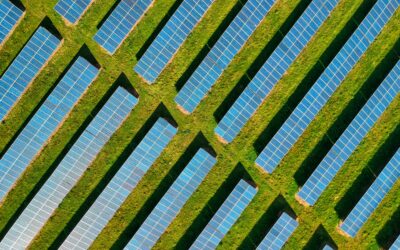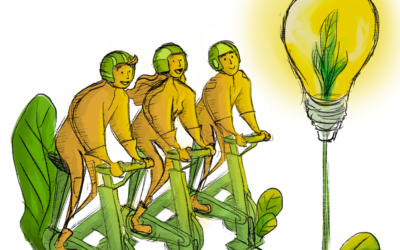Could Crowdfunding Be the Silver Bullet to Unlocking the Financing of Renewable Energy Projects Within Agriculture?
When we talk about renewable energy projects, there’s a growing trend within agriculture that deserves attention: the installation of photovoltaic (PV) panels, or solar panels within fields – agrivoltaics. This innovative concept is relatively new to the agricultural sector, where balancing the energy harvested from the sun for both plants and solar panels presents unique challenges. However, the potential benefits are compelling, particularly for farmers looking to cut energy costs and possibly generate additional income by selling excess energy back to the grid. This opportunity is especially appealing in sun-drenched regions like southern Spain, Italy, and Turkey, where water is scarce but sunlight is abundant.
The benefits of agrivoltaics
The benefits of integrating solar panels within agriculture are indeed many, for example:
- Increased Land Efficiency: Agrivoltaics enable simultaneous use of land for agriculture and energy production, maximizing productivity and alleviating land-use conflicts.
- Optimized Microclimate: The shade from PV panels reduces heat stress on crops, protecting them from extreme temperatures and improving soil moisture retention. This is particularly critical for water conservation.
- Diversified Income Streams: Farmers can generate additional revenue by leasing land for solar panels or producing energy alongside traditional crops, stabilizing their income, or selling the extra energy to the grid.
- Reduced Carbon Footprint: And of course, agrivoltaics help lower greenhouse gas emissions by generating renewable energy.
The initial investment
Despite the advantages, the initial investment required for PV systems can be daunting for many farmers. Although various European initiatives and incentives can ease the financial burden, these are often not sustainable in the long run.
For instance, many incentives available in Italy in 2023 may not exist in 2024. But not only that, sometimes even the project itself daunts the farmers, as it is something very new and at times not standardised / data backed, specifically when it comes to this balance of crop performance and energy collection.
This is where the PV4Plants project comes into play, where Ener2Crowd and 13 other partners around Europe are developing a comprehensive approach to installing advanced PV systems designed to optimize light for both crop growth and energy production and scale this initiative through crowdfunding campaigns and other innovative financial models.
Our role in the project is to create these financing mechanisms, including a crowdfunding campaign specifically for the PV4Plants pilot sites, allowing individuals and communities to invest in agrivoltaic systems and democratizing the funding process.
For more information visit: https://www.pv4plants.eu/.
So how much does a project like this actually cost? On average, a typical agrivoltaic project we help fund costs around 1 million euros. Not every farmer has these funds readily available.
AgriPV systems necessitate a significant initial investment for installation (the CAPEX); infrastructure, grid connection (if applicable), and integration with existing systems like irrigation. This can present a major barrier. Farmers often perceive a higher risk when adopting new technologies, fearing they may disrupt crop yields or operations.
While some subsidies are available in Europe, navigating these options can be challenging, and many farmers lack the financial knowledge or access to optimal solutions. And typically, grants do not cover the full cost, leaving farmers to find an additional 10-50% elsewhere. Banks can also provide financing, but they rarely cover 100% of the expenses.
The important role of crowdfunding
This is where crowdfunding comes in. At Ener2Crowd, we assist farmers in raising the lacking 10-50% of the necessary funds to finance their projects, offering interest rates that appeal to investors without being prohibitive for farmers seeking funds. By activating the local community—and beyond—we enable participation in a good cause while providing substantial financial returns.
Crowdfunding opens investment opportunities to a broader audience, allowing small retail investors to contribute to green energy projects. This approach bypasses traditional barriers to large-scale financing, making it easier for smaller projects to secure the necessary capital. It also fosters a sense of ownership and engagement within local communities, which increases the likelihood of successful project uptake and further initiatives, as people are more inclined to support causes they have a personal stake in. And these same investors within that community, can become what we call an ‘energy community’.
By enabling collective investment in energy production, these communities not only generate local income and reduce energy costs but also create jobs, particularly in rural areas. They increase energy security by reducing dependence on external suppliers and fossil fuels. They also foster social cohesion, as members collaborate towards shared sustainability goals, raising awareness and acceptance of renewable technologies.
As of October 2024, Ener2Crowd’s campaigns have co-financed 3 agrivoltaic projects and has several others in the pipeline, not just in Italy but also in Spain.
Verdict?
So is crowdfunding the solution to all problems related to agrivoltaics uptake? While crowdfunding may not be THE SINGLE silver bullet for financing green energy projects, it certainly plays a crucial role in bringing various elements together. Not only does it address high CAPEX challenges, but it also democratizes green energy, which is essential for scaling similar projects and engaging everyone in the energy transition.
Scopri la piattaforma ed app n°1 in italia per gli investimenti sostenibili e guida la rivoluzione energetica
VOGLIO INVESTIRE IN UN PROGETTOENER2CROWD: NEL MONDO IL 50% PIÙ POVERO POSSIEDE UNA RICCHEZZA CHE PRODUCE 20 VOLTE LE EMISSIONI DI CO2 DELL’1% PIÙ RICCO
In Italia il 50% più povero possiede una ricchezza che produce 8,2 volte gli impatti ambientali negativi del 10% più ricco, 3,6 volte quelli del 40% di mezzo e comunque 3,9 volte la media nazionale. Ener2Crowd, la prima piattaforma italiana di lending...
1% DELLA RICCHEZZA FINANZIARIA GLOBALE PER MANTENERE IL «CARBON BUDGET» AL 2030: L’ITALIA PUÒ FARCELA DA SOLA
Ener2Crowd è convinta che tale impegno non debba partire solo dall’1% della popolazione più ricca del pianeta, concentrando ancora di più potere e disponibilità economica nelle loro mani, ma dal restante 99%. Per raggiungere gli obiettivi al 2030 di mantenimento...
GREEN ENESYS SBARCA SU ENER2CROWD PER REALIZZARE INSIEME AI CITTADINI DUE IMPIANTI FOTOVOLTAICI IN SICILIA DA 6 MWP CIASCUNO
Prende sempre più piede il modello partecipativo nella transizione energetica: questa volta è un’azienda interazionale a scegliere il nostro Paese —ed in particolare la Sicilia— per realizzare, in collaborazione con Ener2Crowd, due impianti fotovoltaici che...
GreenPremio: più è sostenibile e più guadagni
GreenPremio: più è sostenibile e più guadagni ll GreenPremio è il nuovo programma fedeltà di Ener2Crowd dedicato a tutti gli iscritti della piattaforma, ovvero i partecipanti della più grande comunità di investitori etici d'Italia.Attenzione, il GreenPremio si corre...
Il reddito energetico: cos’è e quali sono i possibili sviluppi?
Cos'è il reddito energetico? Il reddito energetico è un incentivo per l’installazione e l’impiego di energie rinnovabili. Lo scopo dell'incentivo è permettere l’accesso a tecnologie rinnovabili anche a chi è interessato ma non ha la disponibilità economica necessaria....
Le comunità energetiche in Italia
Il modello della comunità energetica è uno dei pochi che potrà veramente aiutare una piena transizione energetica alle energie rinnovabili in modo capillare. Vediamo insieme cosa sono le comunità energetiche e il loro sviluppo nel territorio italiano. Cosa sono le...







